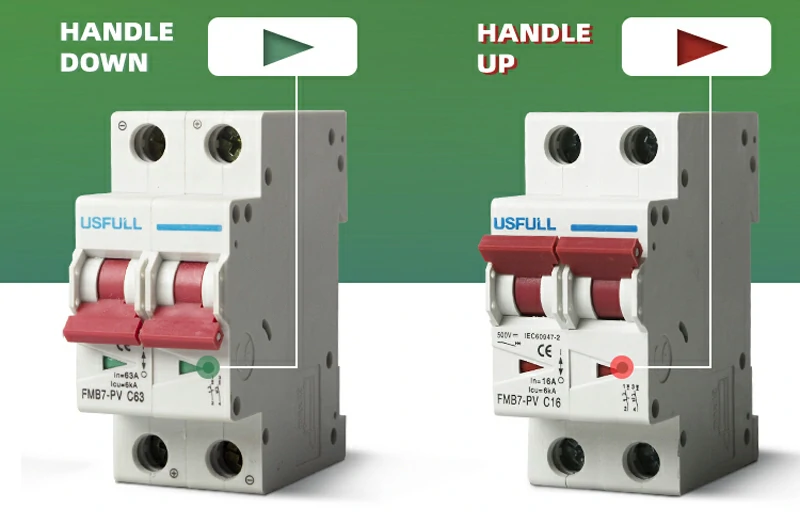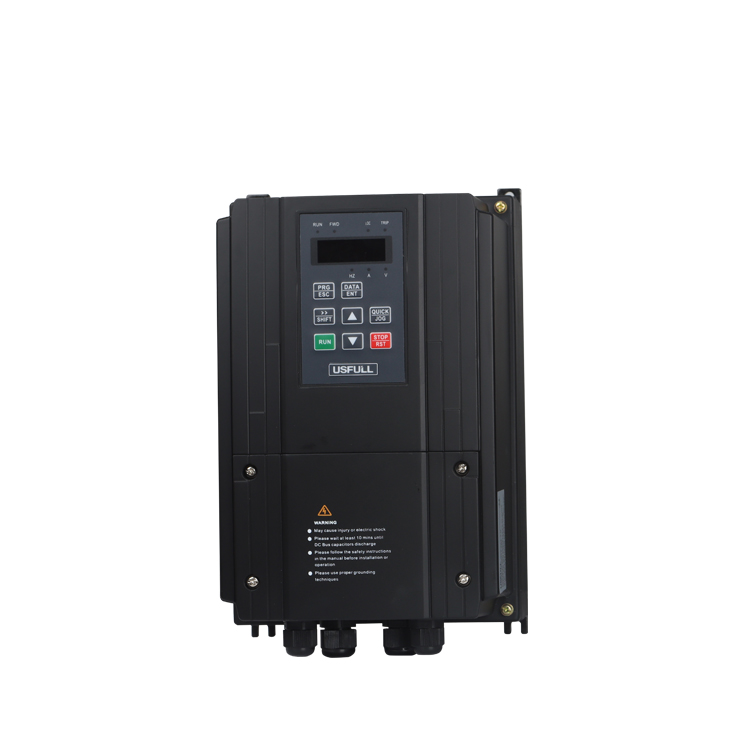Was sind DC-Schutzschalter?
A DC-Schutzschalter ist eine Schutzeinrichtung zur Unterbrechung und Steuerung des Gleichstromflusses in einem elektrischen System. Sie dienen demselben grundlegenden Zweck wie AC-Schutzschalter sondern sind speziell für die besonderen Eigenschaften von Gleichstromkreisen konzipiert.
DC-Schutzschalter sind für den Schutz elektrischer Stromkreise und Geräte vor Überlast, Kurzschlüssen und anderen anormalen Bedingungen verantwortlich, die Schäden oder Gefahren verursachen können. Wenn ein Fehler oder ein anormaler Zustand festgestellt wird, wird ein DC-Schutzschalter öffnet den Stromkreis, so dass kein Strom mehr fließt und weitere Schäden verhindert werden.

Wie funktionieren DC-Leistungsschalter?
A DC-Schutzschalter überwacht den in einem Stromkreis fließenden Strom und unterbricht den Strom, wenn anormale Bedingungen wie Überlast oder Kurzschluss festgestellt werden. Hier ist ein allgemeiner Überblick darüber, wie DC-Schutzschalter Arbeit:
Aktuelle Messung:
A DC-Schutzschalter verfügt über einen Strommessmechanismus (in der Regel ein Solenoid oder ein Stromwandler), der den durch den Stromkreis fließenden Strom kontinuierlich überwacht. Ein Stromsensorelement erzeugt ein proportionales Signal, das auf der Größe des Stroms basiert.
Auslöseeinheit:
Das Signal des Stromsensors wird an den Auslöser weitergeleitet, eine Schutzeinrichtung, die in den Stromkreisunterbrecher. Ein Auslöser analysiert das aktuelle Signal und vergleicht es mit vordefinierten Schwellenwerten oder Merkmalen.
Fehlersuche:
Ein Auslöser überwacht das Stromsignal kontinuierlich auf anormale Bedingungen wie Überlast, Kurzschlüsse und Erdschlüsse. Ein Auslöser erkennt einen Fehlerzustand, wenn der Strom einen vordefinierten Schwellenwert überschreitet oder von seinem erwarteten Wert abweicht.
Auslösesignal:
Der Auslöser erzeugt ein Auslösesignal, wenn ein Fehlerzustand erkannt wird. Dieses Auslösesignal wird an den Stromkreisunterbrecher und löst die Öffnung der Kontakte aus.
Kontaktöffnung:
Die DC-Schutzschalter Der Betätigungsmechanismus öffnet die Kontakte als Reaktion auf das Auslösesignal. Dadurch wird der Stromfluss physisch unterbrochen und der fehlerhafte Stromkreis von der Stromversorgung getrennt.
Lichtbogenlöschung:
Wenn sich die Kontakte auseinander bewegen, wird der Stromfluss unterbrochen und es kann zu einem Lichtbogen zwischen den Kontakten kommen. DC-Schutzschalter verwenden verschiedene Lichtbogenlöschverfahren, um den Lichtbogen schnell zu löschen und ein Wiederaufflammen zu verhindern. Diese Methoden können magnetische Entladungsspulen, Absaugkammern oder andere Lichtbogenlöschmechanismen umfassen.
Stromunterbrechung:
Wenn der Lichtbogen erloschen ist, hält der Schutzschalter die Kontakte in der offenen Position und sorgt dafür, dass der unterbrochene Stromkreis isoliert bleibt. Dies verhindert den Stromfluss, bis der Fehler behoben ist oder der Stromkreisunterbrecher manuell zurückgesetzt wird.
Zurücksetzen und schließen:
Nachdem der Fehler behoben wurde, der Schutzschalter kann durch Schließen der Kontakte manuell zurückgesetzt werden. Es können manuelle oder automatische Rückstellmechanismen verwendet werden, je nach der Schutzschalter Entwurf.
Es ist wichtig zu wissen, dass verschiedene Arten von Gleichstrom-Schutzschaltern unterschiedliche Funktionsprinzipien und spezifische Technologien haben können. Das allgemeine Prinzip ist jedoch dasselbe, nämlich die Erkennung anormaler Strombedingungen und die Unterbrechung des Stromflusses zum Schutz des Stromkreises und der angeschlossenen Geräte.
Die Vorteile von DC-Leistungsschaltern:
DC-Schutzschalter haben bei bestimmten Anwendungen mehrere Vorteile gegenüber AC-Schutzschaltern. DC-Schutzschalter haben die folgenden Vorteile:
1. Verbesserte Lichtbogenlöschung:
DC-Schutzschalter sind darauf ausgelegt, Gleichstromlichtbögen effektiver zu behandeln und zu löschen. Gleichstromlichtbögen sind im Allgemeinen schwieriger zu löschen als Wechselstromlichtbögen, da Gleichstromsysteme keinen Nulldurchgangspunkt haben. DC-Schutzschalter haben einen speziellen Lichtbogen-Löschmechanismus: B. Magnetische Löschspule, um den Lichtbogen schnell zu löschen und eine erneute Zündung zu verhindern.
2. Niedriger Spannungsabfall:
Gleichstrom-Leistungsschalter haben im Vergleich zu Wechselstrom-Leistungsschaltern in der Regel einen geringeren Spannungsabfall an den Kontakten. Dies ist vorteilhaft für Anwendungen, bei denen die Spannungsstabilität von entscheidender Bedeutung ist, da es den Leistungsverlust minimiert und eine präzisere Steuerung des Gleichstromsystems und der Anschlüsse des Gleichstromleistungsschalters ermöglicht.
3. Verkürzte Reaktionszeit:
Gleichstrom-Leistungsschalter haben im Vergleich zu Wechselstrom-Leistungsschaltern oft eine schnellere Reaktionszeit. Da Gleichstromsysteme keine Nulldurchgangspunkte haben, können Fehler schneller erkannt und beseitigt werden, was einen schnelleren Schutz gegen Kurzschlüsse und andere anormale Bedingungen bietet.
4. Kompakte Größe:
DC-Schutzschalter sind kompakter und leichter als AC-Leistungsschalter mit demselben Nennstrom. Der Grund dafür ist, dass Gleichstromsysteme im Allgemeinen kleinere Abmessungen und weniger Komponenten für den Betrieb haben.
5. Erhöhte Selektivität:
A DC-Schutzschalter kann die Selektivität verbessern. Mit anderen Worten: Im Falle eines Fehlers wird nur der fehlerhafte Teil des Stromkreises isoliert, während der Rest des Stromkreises nicht betroffen ist. Dieser selektive Betrieb minimiert Ausfallzeiten und Störungen in angeschlossenen DC-Systemen.
6. Kompatibilität mit DC-Netzteilen und -Lasten:
DC-Schutzschalter sind speziell für die Eigenschaften von DC-Stromquellen und -Lasten ausgelegt. Sie können Gleichstrom unterbrechen und steuern, ohne die Beschränkungen von AC-Schutzschaltern, die für Wechselstrom optimiert sind.
7. Sicherheitsaspekte:
DC-Schutzschalter kann fortschrittliche Sicherheitsfunktionen bieten, wie z.: B. Störlichtbogenerkennung, Erdschlussschutz, Überlastschutz. Diese Funktionen tragen dazu bei, den sicheren Betrieb und Schutz von Gleichstromnetzen und den daran angeschlossenen Geräten zu gewährleisten.
Die Vorteile von DC-Schutzschalter sind vor allem für Gleichstromsysteme relevant, wie z. B. Gleichstromschalter für Photovoltaikanlagen, Gleichstromschalter für Batteriesysteme, Gleichstromschalter für Elektrofahrzeuge und bestimmte industrielle Anwendungen. Es ist wichtig, dies zu beachten. AC-Leistungsschalter sind immer noch die Standardwahl in traditionellen AC-dominierten Stromnetzen.



